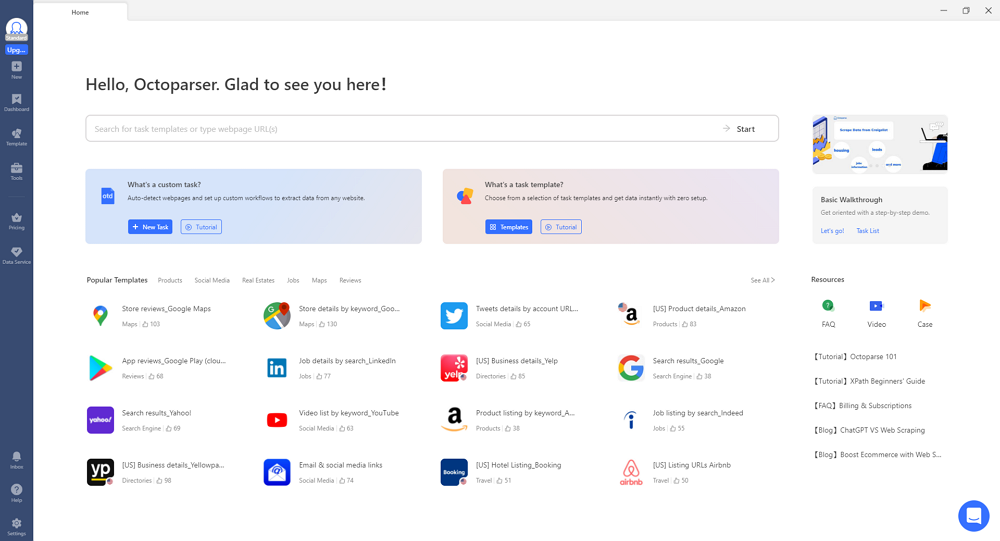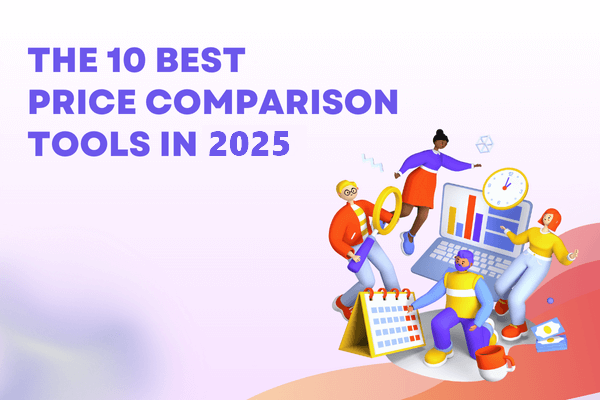Pricing is essential for attracting clients and achieving revenue in the cutthroat market of today. Businesses need to use price monitoring and dynamic pricing methods to remain ahead of the curve. This article will discuss the idea of price monitoring, the effectiveness of dynamic pricing, and how Octoparse and web scraping may completely change the way you approach pricing.
Price Monitoring 101
Price monitoring is the systematic process of tracking and analyzing competitor prices, market trends, and customer behavior to make informed pricing decisions. But why is it so crucial for businesses? Well, let’s find out.
To begin, pricing monitoring enables you to remain competitive in an ever-changing industry. You can uncover opportunities to change your rates by keeping a careful eye on your competitors’ pricing practices. This keeps you competitive and attracts price-sensitive clients.
The Benefits of Price Monitoring
Strategic Pricing Decisions
Price monitoring provides valuable insights into competitor prices, allowing you to make strategic pricing decisions. By analyzing the market landscape, you can identify opportunities for price adjustments, discounts, or promotions. This enables you to position your products or services competitively and maximize profitability.
Improved Profit Margins
Effective price monitoring helps you optimize profit margins. By identifying pricing gaps or areas where you can offer a better value proposition, you can adjust your prices to increase revenue while maintaining healthy margins. This ensures that your pricing strategy aligns with your business goals and profitability targets.
Enhanced Customer Attraction and Retention
Monitoring prices help you understand how customers respond to different price points. By analyzing customer behavior and preferences, you can tailor your pricing strategy to attract and retain customers. Whether it’s offering competitive prices or implementing dynamic pricing strategies, understanding customer dynamics allows you to provide value and increase customer loyalty.
Market Positioning and Brand Perception
Price monitoring enables you to position your brand effectively in the market. By bench-marking your prices against competitors, you can ensure that your brand is perceived as offering fair and competitive pricing. Consistently monitoring prices helps you maintain a strong brand image and build trust with your target audience.
The Challenges of Price Monitoring
However, price monitoring is not without its challenges. Let’s explore some common obstacles businesses face when implementing price monitoring strategies:
Data Volume and Complexity
With numerous competitors and a vast range of products or services, managing and analyzing pricing data can be overwhelming. The sheer volume of data requires robust tools and techniques to collect, organize, and analyze it effectively. Investing in price monitoring solutions and automation tools can help streamline this process.
Real-Time Monitoring and Response
The market landscape is dynamic, with prices changing frequently. To respond swiftly and effectively, businesses need real-time monitoring capabilities. Monitoring prices manually can be time-consuming and inefficient. Implementing automated price monitoring systems or using web scraping tools allows you to gather real-time data and respond to market changes promptly.
Competitive Intelligence
Gathering accurate and comprehensive competitor data can be a challenge. Competitors may employ various strategies to protect their pricing information, making it difficult to access reliable data. Overcoming this challenge requires advanced techniques such as web scraping or utilizing specialized price monitoring tools that can extract competitor pricing data from various sources.
Price Discrimination and Personalization
With dynamic pricing strategies, businesses aim to offer personalized pricing to different customer segments. However, implementing personalized pricing without engaging in price discrimination can be complex. Balancing the need for customized pricing while ensuring fairness and transparency requires careful consideration and adherence to legal and ethical standards.
Price Monitoring and Dynamic Pricing
Dynamic pricing, also known as surge pricing or demand-based pricing, is a pricing strategy that involves modifying prices in response to multiple factors such as supply and demand, time of day, consumer groups, and even rival prices. Dynamic pricing allows organizations to maximize income by charging the appropriate price at the appropriate moment.
Price monitoring and dynamic pricing go hand in hand. Effective price monitoring provides you with the necessary data to implement dynamic pricing strategies successfully. By constantly monitoring the market and competitor prices, you can identify opportunities to adjust your prices dynamically and capitalize on changes in demand.
For example, let’s say you run an e-commerce store selling electronics. Through price monitoring, you notice that a competitor has reduced the price of a popular product. With dynamic pricing, you can swiftly respond by lowering your price slightly to remain competitive while still maintaining profitability. This real-time adjustment ensures that you capture the attention of potential customers who are comparing prices.
Numerous real-life examples demonstrate the power of dynamic pricing. Airlines, ride-sharing companies, and online retailers frequently utilize this strategy to optimize their revenue streams. By dynamically adjusting prices based on factors such as available inventory, time of booking, and customer behavior, these companies have successfully increased their profits and market share.
How Web Scraping Boosts Price Monitoring
Web scraping is a technique that allows you to extract data from websites automatically. When it comes to price monitoring, web scraping proves to be a game-changer.
Efficient Data Extraction
Web scraping enables you to gather vast amounts of pricing data from various sources quickly and accurately. With a web scraping tool like Octoparse, you can automate the data extraction process, saving you valuable time and resources. Instead of manually visiting each competitor’s website and copying prices, web scraping automates the task, allowing you to collect comprehensive pricing data from multiple websites in a fraction of the time.
Comprehensive Market Insights
Web scraping offers you a thorough picture of the market environment by extracting rival pricing, product descriptions, and customer reviews. You may collect thorough data on price patterns, product attributes, and client attitudes. These insights enable you to make data-driven price decisions based on a comprehensive market picture, ensuring that your pricing strategy stays competitive and in line with consumer expectations.
Enhanced Competitor Analysis
Web scraping enhances competitor analysis by providing you with valuable information on your competitors’ strategies. By scraping data from your competitor’s websites, you can uncover their promotional strategies, product offerings, pricing tactics, and other critical information. This knowledge gives you a competitive edge, allowing you to adjust your pricing strategy accordingly, differentiate your offerings, and identify opportunities for improvement.
Real-Time Monitoring
Web scraping allows for real-time tracking of rival prices and market fluctuations. You may remain up to date with the newest pricing information by automating the scraping process and setting up recurring actions. Real-time monitoring enables you to respond quickly to pricing swings, alter your rates as needed, and maintain a competitive market position. Web scraping provides firms with quick data extraction, in-depth market insights, improved competition research, and real-time monitoring capabilities. You may obtain vital price data, gain a competitive advantage, and make educated pricing decisions that drive your business’s success by employing web scraping solutions like Octoparse.
Scrape Prices with Octoparse in Five Steps
Now that we understand the importance of web scraping, let’s explore how to leverage Octoparse, a powerful web scraping tool, to scrape prices effectively.
Start by downloading and installing Octoparse from the official website. Once installed, launch Octoparse and sign up for a free account to log in, then you can access a set of powerful features.
Step 1: Create a new task
Copy the URL of the website from which you want to scrape price data. This could be your competitors’ websites, e-commerce platforms, or any other relevant sources. Next, paste the URL into the search bar on Octoparse. Click “Start” to create a new task, and Octoparse’s built-in browser will quickly load the webpage.

Step 2: Select the desired price data
Wait for the page to finish loading completely. Octoparse’s built-in browser allows you to navigate and interact with the website to locate the target price data. Click “Auto-detect webpage data” in the Tips panel. It is a smart extraction rule that automatically identifies similar data points on multiple pages, ensuring accurate and consistent extraction. All the detected data will be highlighted on the page for preview.
Step 3: Refine Scraped Data
After selecting the desired price data, review and refine it to ensure accuracy and consistency. Octoparse provides a Data Preview panel at the bottom of the screen where you can preview the extracted data.
Step 4: Create and refine the scraper
Click “Create workflow” to build the price scraper. A diagram will appear on the right side, depicting the step-by-step process of your scraper. By clicking on each action, you can preview and verify that the scraper functions as expected.
Step 5: Schedule and automate the scraping process
Click on the “Run” bottom to launch the scraper. Octoparse allows you to schedule recurring price scraping tasks, ensuring that you always have up-to-date pricing information. Set the frequency and time for the scraping task to run automatically.
Once the scraping process is complete, you can export the scraped price data for further analysis. Octoparse supports various formats, such as Excel, CSV, JSON, or even direct integration with databases like Google Sheets.
After that, you can utilize data visualization tools or statistical software to gain valuable insights from the scraped price data. Analyze pricing trends, identify opportunities for optimization, or monitor your competitors’ performance to make informed pricing decisions.
Conclusion
Price monitoring and dynamic pricing are essential strategies for businesses aiming to optimize revenue and stay competitive. By embracing web scraping techniques with tools like Octoparse, you can efficiently gather pricing data, outperform your competitors, and make data-driven pricing decisions. Start implementing price monitoring and dynamic pricing strategies today to unlock new opportunities and drive your business’s success in the dynamic market landscape.




